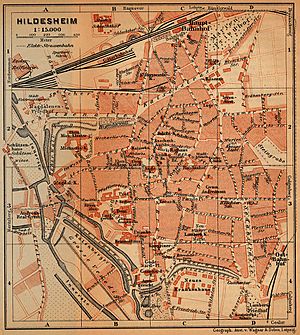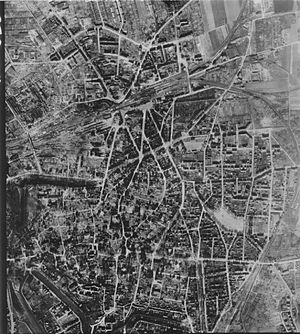Bombing of Hildesheim in World War II facts for kids
Hildesheim is a city in Germany, about 30 kilometers south of Hanover. During World War II, Hildesheim was attacked by Allied planes eight times in 1944 and 1945. These attacks caused a lot of damage to the city.
Contents
Hildesheim During World War II
In 1939, about 72,000 people lived in Hildesheim. For most of the war, the British military didn't see Hildesheim as a major target. They thought its factories weren't that important for the war effort.
However, several factories in and around Hildesheim made important things for the war. For example, the VDM-Halbzeugwerke factory made parts for airplanes, like propellers and landing gear. Other factories produced fuses, tank parts, torpedoes, and rubber items like life jackets. There was also a secret factory called "ELFI" (later Trillke-Factory) that made parts for truck and tank engines. Hildesheim also had a large train yard where goods and supplies were moved around.
Air Raids on Hildesheim
Allied planes bombed Hildesheim several times. Here's a look at some of the main attacks:
Early Attacks in 1944
- July 29, 1944: The first attack hit a sugar factory and slightly damaged the train yard. 34 people died. The city center was not hit.
- August 12, 1944: Bombs hit the sugar factory again and slightly damaged the VDM metalworks. Some bombs also fell on a residential area, destroying one house and damaging others. Sadly, 10 prisoners of war (POWs) were killed when bombs hit their camp.
- November 26, 1944: Hildesheim was likely a backup target this day. A few bombs hit forests and the city center for the first time. No one was killed, but some houses were damaged.
Attacks in 1945
- February 13, 1945: An aerial mine exploded near a tennis court at night. No one died, but hundreds of roofs in the city center and nearby neighborhoods were damaged.
- February 22, 1945 (Operation Clarion): This attack was part of a bigger plan to destroy German transport centers. The main target was Hildesheim's train yard, which was badly damaged. The city also suffered a lot: 102 houses were destroyed, and 106 houses and two churches (St. Bernward's and St. Lamberti) were severely damaged. Many other buildings, including the famous Cathedral and Saint Michael's Church (which are now World Heritage Sites), had minor damage. About 250 people were killed.
- March 3, 1945: Hildesheim was a backup target again when another city, Braunschweig, was bombed. Over 500 bombs fell on a residential area in eastern Hildesheim. 51 houses were destroyed, and 52 people died.
- March 14, 1945: Planes targeted the VDM metalworks and the train yard again. The train yard was hit hard and couldn't be used for days. The VDM factory was missed, but a different metal factory, Senking, was destroyed. About 150 people were killed, including 60 POWs. In the city, 18 houses were destroyed.
The Main Attack: March 22, 1945
On March 22, 1945, Hildesheim was the main target for Allied bombers. British and Canadian planes were ordered to destroy the city, its factories, and its railway lines. Around 250 bomber planes attacked at 2 a.m. For 15 minutes, they dropped a huge amount of high explosive and incendiary (fire-starting) bombs.
Almost 74% of Hildesheim's buildings were destroyed or damaged in this attack. This included nearly the entire historic city center, which had kept its medieval look until then. Famous buildings like the Cathedral, Saint Michael's Church, and St. Lamberti were destroyed. Even though the historic center didn't have much military importance, it was bombed to try and break the will of the people to continue fighting, just two months before the war in Europe ended. Around 1,500 civilians were killed in the March attacks, and about 500 of them could not be identified.
After the War
After the war, about 34,000 people, or almost half of the city's population, were left without homes. Reconstruction began quickly. On June 12, 1945, workers started clearing the rubble, and by June 26, the first new houses were being built. By February 1947, 350 houses had been rebuilt.
Like many cities, Hildesheim focused on building new homes quickly. Often, concrete buildings replaced the older, destroyed ones. However, the churches, including the two now recognized as UNESCO World Heritage Sites, were rebuilt in their original style. The Cathedral took ten years to rebuild (1950-1960), and Saint Michael's Church was rebuilt from 1946 to 1960. During the war, valuable items from these churches had been hidden safely in the city wall's basement.
In the 1980s, efforts began to rebuild parts of the historic center. Some of the less attractive concrete buildings around the historic market place were torn down. They were replaced with copies of the original buildings, like the famous Butchers' Guild Hall. In 2007, a decision was made to rebuild the "Upended Sugarloaf," a unique half-timbered house known for its unusual shape. It was finished in October 2010.



